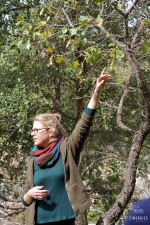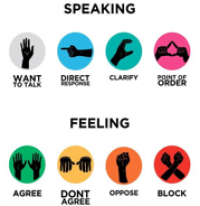Table of Contents
Facilitation
Setting up for the Tour
The Tour adopts a horizontal facilitation approach of non-formal education. This means that facilitators are also considered as learners, for which it is essential that all phases of the “facilitation cycle” – preparation, implementation, evaluation and follow-up – are addressed the same way as it is with participants.
Creating a team
It is important to keep in mind that each facilitation team works differently and enough time should be dedicated to the preparation phase, especially when working together for the first time.
The team of facilitators has to agree on the roles, on the terms of conflict resolution, on their decision making method, on their approach regarding the group of participants etc. An initial agreement in-between the team of facilitators makes the implementation of the program smooth and saves time when dealing with problems or making decisions.
 It will be up to you to decide how you build your team.
For example, in one former Heterotopia Tour with young people, the facilitation team was composed of the Youth Leaders (accompanying persons of each national groups), of the Coordination Team (staff of the hosting organization) and of External Experts for specific sessions of the Tour. All those people had to decide how to get organized as a team.
Here are some questions that came up before and during the facilitation of the Tour:
It will be up to you to decide how you build your team.
For example, in one former Heterotopia Tour with young people, the facilitation team was composed of the Youth Leaders (accompanying persons of each national groups), of the Coordination Team (staff of the hosting organization) and of External Experts for specific sessions of the Tour. All those people had to decide how to get organized as a team.
Here are some questions that came up before and during the facilitation of the Tour:
- What is the exact role of the youth leaders? Are they only responsible for the group dynamic and for supporting the participants, or should they also facilitate activities?
- What is the method we choose to make sure that each member of the facilitation team receives the information on decisions made in spontaneous situations as quickly as possible?
- How does the team manages the plenary sessions after the activities? Is it co-managed, or the responsibility of the facilitator of the activity? To what extent may co-facilitators step in during the facilitation of an activity?
- To what extent should facilitators get involved in certain personal situations between participants?
- What is the limit of “living space” for participants to experiment, to make errors, to “learn on their own skin” without the facilitators stepping in?
Both questions and answers can vary from Tour to Tour, depending on the profile of participants, on the learning space, on safety regulations and agreements with the local partners, on facilitation styles, etc. In any case, the quality of the preparation and of the communication between team-mates will be crucial.
What happens to facilitators during the Tour – “We are our own guinea-pigs”
As we mentioned, facilitators are also learners in a non-formal setting, which means that they also will get out of their comfort zone so they can grow personally and professionally.
 Before the Tour facilitators should go through the same preparation process as participants: they should set personal learning objectives, analyze their strengths and weaknesses, their fears and expectations and share it with the other members of the team.
The same rules apply to facilitators as to the participants: the team has to find a way to function at its best, considering individual needs and the needs of the team as a group. It is important to work beforehand on group dynamics within the facilitation team, given the fact that they will be a reference point and an example for the participants.
Before the Tour facilitators should go through the same preparation process as participants: they should set personal learning objectives, analyze their strengths and weaknesses, their fears and expectations and share it with the other members of the team.
The same rules apply to facilitators as to the participants: the team has to find a way to function at its best, considering individual needs and the needs of the team as a group. It is important to work beforehand on group dynamics within the facilitation team, given the fact that they will be a reference point and an example for the participants.
During the Tour facilitators should monitor how their team is functioning and how their own learning process is turning out. This approach also creates a stronger trust-relationship with participants: experiencing the same situation and sharing what we’ve learned about ourselves create stronger connections and leads to accepting guidance.
The role of facilitators
During implementation, the role of facilitators is to “hold space” – to create and maintain stimulating circumstances for participants that allows them to explore and try out new things and ideas, releasing their own potential.
Facilitators are not responsible for the results; they merely create the appropriate starting point. They only get involved in the natural flow of dynamics when the “space” is in danger, making sure that participants have a safe space and the resources needed for learning and that their basic needs are satisfied, so they won’t get distracted.
As Chris Corrigan says in The Tao of Holding Space:
“The middle of the space is empty. It is itself, the space of invitation, a space of possibility, a space that gives rise to any potential, any direction, any result. Open Space is a way of navigating everything and nothing. Holding space is the art of being completely present, and totally invisible.”
"Radical Flexibility" as a compass
The concept of “Radical Flexibility” was used for the first time during a Heterotopia Tour in 2015 to define the facilitation process we were using at that point. From then we have kept it as a compass for the facilitation team.
“Radical Flexibility” is about taking into account people’s experiences, expectations and needs, without losing sight of the tasks at hands and of the responsibilities the organization team has towards its partners. It involves balancing out the needs of every “cell” involved (the individuals within the group, the group, the partners, the project in itself) for the sake of the whole “organism”.
In practice, it stands as a guideline for the facilitators, based on the following principles:
- Federating: bring people together, welcome and take care of each person, create an atmosphere of trust, confidence and emotional security;
- Guarantying freedom of speech, respect and solidarity between the participants; encourage them to express themselves, to say what they may not have said otherwise;
- Mandating: Give responsibility to people, share tasks and facilitate one’s involvement; advocate for reciprocity (check the balance between what one gives to the group and receives from the others) and support people in their initiatives;
- Clarifying: Pay attention to the way information is spread and shared, ensure the respect of the basic collective rules, even if they might change after a while according to the upcoming needs;
- Listening to and answering participants’ expectations / questions / frustrations / satisfactions; Accept dealing with problems as soon as they appear; communicate with everybody to understand divergences to solve them, address and calm down tensions when they occur; take time for meetings, be transparent on what is going on;
- Listening and answering to partners, to ensure the quality of the training cession(s);
- Evaluating what was done daily, to improve constantly;
- Anticipating what could happen as much as possible;
- Thinking positive: Be open to collective intelligence, look for alternatives when needed, make efforts to get the best out of tense situations, gather people and take their points of view into consideration to find new solutions together, give perspectives;
- Thanking participants and partners for their commitment, celebrate the group’s achievements.
Of course, such a facilitation requires a strong dedication to the project from the facilitators. Almost a 24/7 commitment during the length of the Tour! But we believe it also requires humbleness, humor and ability to recognize one's mistakes and to welcome criticism in order to keep the moral of the participants up and to make the most out of any experience, either it is positive or negative.
Time management - a collective responsibility
“We don’t have enough time to finish the task” - “We don’t have enough time to discuss the topic in details” - “We don’t have enough free time” - “We have too much free time”
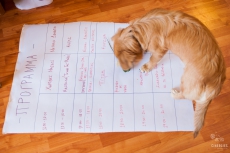 These are some feedback of participants we've heard during previous Heterotopia Tours. Time management is a crucial element of the Tours, since it can strongly affects the learning outcomes, dynamics and mood of the group. The schedule of the program, including informal time, has to be planned in a way that it can satisfy the needs of participants regarding time: enough time to explore and experiment; time to process and organize information; time to think, to discuss and to come up with a collective understanding; enough time for yourself and enough informal time to spend with others.
These are some feedback of participants we've heard during previous Heterotopia Tours. Time management is a crucial element of the Tours, since it can strongly affects the learning outcomes, dynamics and mood of the group. The schedule of the program, including informal time, has to be planned in a way that it can satisfy the needs of participants regarding time: enough time to explore and experiment; time to process and organize information; time to think, to discuss and to come up with a collective understanding; enough time for yourself and enough informal time to spend with others.
In order to follow a balanced schedule, that is to say “have enough time for everything”, facilitation is needed since participants tend not to respect time limits. Indeed, when they are fully engaged in an activity, they focus on what is happening at the moment and don't worry if there will be enough time for the next activity/ free time. Facilitators should always inform participants before an activity about how much time is available to carry it out, and remind them at least half-an-hour and 5 minutes before the time is off. This way the participants will keep a sense of time and deal with less frustration (activity left unfinished, shorter break…).
In some situations it is necessary to be flexible about the time schedule:
- When giving some extra time so an activity can reach a higher level of learning outcomes
- When there is a conflict arising and it has to be prevented/managed
- When the emotional state of participants needs to be uplifted
- When there are external factors that are affecting the activities
- When the group collectively decides to change the time schedule, because it doesn’t fit their needs
Time management is also a learning experience for participants : it is important that facilitators help the learners realize that the whole group is responsible for how it spends the time available to reach each personal and collective objectives. Being co-responsible for time management improves the capacity of the participants to focus, get organized, practice respect for the group and to learn how to prioritize. (You can read about different tools that can facilitate time management under the following chapter.)
Improving the self-awareness of the participants (acknowledging their personal needs) can help them manage their time better and respect the schedule of the group. For example, if a participant is always late in the morning, they might need more time for their morning routine; in this case the participant has to adjust their waking up time. This means that they might have to “sacrifice” an hour or more from the informal night-time on the night before in order to get a good night sleep – it all comes back to prioritizing again.
In any case, when there are difficulties in the group with time management, it is important to address the issue with the group before creating a habit of not respecting the time schedule and risking not to reach the objectives of the Tour. Here are some guiding questions for group reflection:
- At specific issues regarding the schedule and time management: are we talking about a collective issue or a personal one?
- Do we really not have enough time or are we just misusing the time we have?
- Which are the factors (internal and external) that limits us in managing well our time? Can we eliminate them?
- How do we use our free and informal time? Do we take advantage of those moments to fulfil our needs (be it a personal need or a need for learning) or we just “hang around” between scheduled activities?
- How could we manage our time better? What tools or methods could we use? (If we claim that something is not working, we are responsible for offering alternatives!)
- If we collectively decide to change time schedule, how can we do it in a way that it doesn’t affect the achievement of the objectives?
- Which are the risks of changing the time schedule? Are we okay with those?
Time management is a sensitive issue because each person has a different perception of time and a different need regarding the amount of time needed to fulfill their needs; it is a collective responsibility to help each other make the most of their time: let’s be each other’s caring friend who wakes the other up, or who saves coffee for the other when they are late for breakfast so they don’t lose time with making some more when the activities have already begun.
Advice and tools to assess and improve the group dynamic
As the Heterotopia Tour largely revolves around community living (which involves times for discussion between the participants or with external partners), we believe it is crucial to put some facilitation into place to enable a variety of participants with their specific needs and preferences to express and make the most of each activity.
The following piece of advice mostly applies to discussions within the whole group but the principle can be adapted to any activity. They are few things to be aware of in order:
- to know when the group is getting bored or tired so you can react and maintain an interesting pace and group dynamic;
- to better design the facilitation frame from one Tour to the next after monitoring what improved or destroyed the dynamic;
- to take different types of people into account so they feel listened to and respected.
Let different voices be heard.
During a discussion, some people will remain silent for most of the session. It doesn't necessarily mean they have nothing to say! By using a variety of facilitation techniques, you maximize your chances of reaching every participant along the Tour. This includes: spoken, written or silent activities, using gestures, art, music, games, activities with a fast or slow pace…
Gestures (as the Sociocracy gestures) in particular can help the facilitator understand the reasons behind somebody has been silent for the whole activity:
For instance, it can be that the participants were speaking too low and they couldn’t hear: after asking 2 times if people could speak up, they stopped so they wouldn’t annoy the group. With a simple gesture they can express their problem without interrupting the discussion.
Likewise, some people might need a change of pace, someone to rephrase the topic of the discussion or want to express their frustration after the group has been repeating the same thing several times or gone off-topic. The gesture will help them express those things without interrupting so the group can immediately react, which will help them get back into the discussion.
The above signs are an example found for the “Occupy Movement”. You can find others and/or create your own. In any case, having a poster with the different signs you intend to use will help people remember what options they have. You should also make sure all the participants involved in the discussion can see each other.
Keep the pace, stay on course
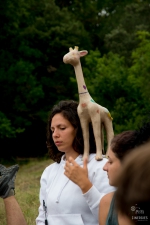 Using „roles“ during meetings, and especially during decision-making discussions will help the group to stay on course at the same time it will help some people take part into the activity (it is sometimes more fulfilling for some people to have a specific mission during a discussion in order to stay focused).
Using „roles“ during meetings, and especially during decision-making discussions will help the group to stay on course at the same time it will help some people take part into the activity (it is sometimes more fulfilling for some people to have a specific mission during a discussion in order to stay focused).
You can use “usual” roles such as Time-Keeper, Facilitator, Leader and Recorder or come up with other roles that you will consider more suited to the activity. You can also have two people keeping the same role at different times so they can change point of view on what is going on.
In the case of the Heterotopia Tour, 2 roles are often used to ease the process: the Time-Keeper and the Decision-pusher
The Time-Keeper is responsible for keeping the group aware of the time remaining for the activity regularly. Usually the facilitator also deals with time management but having a participant plays this role allows the facilitator to focus on the group dynamic.
If the group decides to use this role for an activity, then it has to stop the meeting when the time is up, or decide to add a set amount of time to end the discussion. The purpose is to avoid endless meeting and accept the fact that a decision could or couldn't be made in this time, and reflect on the reasons why: Was the group going off-topic? Was the set time for the meeting too short to reach à solution? Did the facilitation manage to use the right pace and tools to help the group focus?
Being aware of the time factor means the participant expect the discussion to end at a specific time: they are responsible for being focused and try to be as clear as possible so each item is addressed in the most efficient way.
The Decision-pusher is helping in that matter. Its role is to have an overview of the arguments and be able to sum-up the different propositions clearly and start a vote. They will force the group to close one topic (with a decision/vote) before addressing another topic. When the time is almost up, they will sum up the propositions for the last topic addressed and propose a vote. If the propositions are not satisfying for most of the group, they, with the facilitator, can propose to add 15 minutes (maximum) to close the topic efficiently.
Whatever the roles you decide to set up (for instance : 1 facilitator, 1 time-keeper and 1 decision-pusher), the people who will endorse them should work together and if possible, take a few minutes to overview the schedule for the meeting beforehand.
Keep in mind that facing an unfinished decision will be frustrating for the group, but it will be even more painful if the discussion has lasted for hours with no-one knowing when the decision will be reached! Being firm on the time schedule is not a pain in the neck ; it is a gift for the community! It allows for the group to make a step forward, to rest after an intense meeting and to learn to make concessions for the sake of the group.
Observe and analyse
In order to gauge the effect of your facilitation on the group dynamic, you should observe what happens.
Seeing that the group is very focused or very bored is a thing, but the real question is to determine how you as a facilitator as well as the whole group helped or impeded this process. Don't forget external causes such as tiredness, weather, expectations… : they may play a key role.
In order to get an idea on how to improve the dynamic of your group, we advice you to:
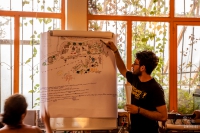
- create some factual criteria to observe : number of questions or breaks asked, suggestions made, yawning, people chatting aside from the group…
- set a time-period to make the observation (one hour everyday, 3 hours every 3 days, the whole day on the first, middle and last day of the Tour…). You should use the program to assess which days will be best suited;
- pay extra attention when changing pace in the facilitation (energizer, ending the discussion, going from a manual to an intellectual activity): Did the participants react well to the change? Was it welcomed or did it break the flow of the group?
- try to write down any comment you might hear to get a better idea of how some individuals feel (“I’m bored”, “I can use this tool at home!”, “I need a smoke”, “We said this already”, “What is on the menu for lunch?”).
You should keep a log of the comments, attitudes and level of comitment of the participants throughout the activities of the day so you can keep track of what you’ve observed and share it with your team-mates during the next meeting.
If you intend to learn more about how one participant in particular is affected by the Tour it might be worth observing this person’s behavior within the group while taking into account their initial expectations and previous community living experiences.
For example :
Person A is new to community living. He hasn’t talked much on day one. On day 7, he asked several questions and made a suggestion. On day 15 he was speaking a lot more, making suggestions and clarifying topics for the group. It seems the Tour managed to raise his confidence within the group.
Person B is experienced in community living. On day one, she was participating a lot, and making many suggestions. On day 7, she participated a bit less and asked more questions. On day 15 she was making suggestions again and clarifying things for the group. We can suggest that she had a preconceived idea of what the Tour should look like thanks to her past experience, but was open to reconsider it – she trusted the organization team and the group and got invested even more in the end. You managed to gain her trust… How? That’s when interviews can help…
Individual interviews as a tool to accompany people out of their confort zone
A " 'you' time" to better understand the participants' background, motivations and emotional state
As thriling and inspiring the collective Heterotopia Tour can be, it can sometimes get hectic, intense and emotionnally overwelming for some participants. An individual interview can represent a chance for each individual to get away from the collective bustle, relax for a while, listen to oneself and feel fully heard.
The interview tool is about creating an individual space within the collective trip, in which all participants have the opportunity to get away from the group, to look inwards, tell their own stories, remember their initial motivations to participate to the Tour and put it in perspective with the reality they are living. It’s a good way to stop for a while and question ourselves about the moment in our life in which the Heterotopia Tour occurs, and which key elements it brought us.
It’s a moment in which some people will feel the need of expressing their emotions, their satisfaction but also their fears, problems or challenges encountered during the Tour. Sometimes some of them might also share very personal informations about their life and past experiences. As a facilitator, be ready to benevolently welcome them and listen in a non-judgmental way.
 Allowing an individual time for each participant might actually help some of them to get more involved within the group. This « ‘you’ time » creates a space in which any kind of existing discomfort or frustration can be expressed and should be welcomed by the person interviewing. For this reason, make sure the person conducting the interview is willing to listen and help participants get any uneasy feeling out of their chest.
Allowing an individual time for each participant might actually help some of them to get more involved within the group. This « ‘you’ time » creates a space in which any kind of existing discomfort or frustration can be expressed and should be welcomed by the person interviewing. For this reason, make sure the person conducting the interview is willing to listen and help participants get any uneasy feeling out of their chest.
Once shared with someone else of the group, the discomfort might ease up, a solution to the problem expressed might be found between the participant and the interviewer. The participant might return to the group relieved and experiment the following collective processes in a more comfortable way.
An opportunity for improvement
Beyond their impact on the participants themselves, the interviews will be an opportunity for you (as the facilitation team) to understand what are the participants' profiles, to hear about the way they’re experiencing the Tour, what they feel at ease with and inspired by, and what they’re challenged by.
The interviews will enable some people to voice their impressions about the way the Tour is going on or issue some pieces of advice. Collecting them and then sharing and analyzing them with the whole organizing team is precious. On the one hand, to a certain extent, the interviews will allow you to adapt animation and facilitation methods for the ongoing Tour, according to personalities and sensitivities, for the Tour to be as inclusive as possible.
On the other hand, they will be a huge source of information to understand better the motivations and expectations of people who decide to be part of the Tour, thus giving ideas to improve the future ones. They allow to link each person’s behavior and participation within the group with their “profile” and design future projects so that they will be even more inclusive.
A few tips to organize and lead the interview
As a facilitator, you need to establish a climate of trust with the person you will interview so that they feel at ease and share their thoughts and feelings. We recommend the following:
- Step aside from the group and make sure the interview is experienced as a private moment;
- Do not record the talk, prefer taking notes after asking permission to the person interviewed;
- Explain to the person what are the objectives of the interview and define together the way you will conduct it.
The content and the frame of the interview will depend on your skills, on the participant's profile and on your common objectives. For instance, some objectives and questions could be :
- Understanding profiles: age, origin, family background, mobility, studies, work experiences, lifestyles, major life milestones, collective experience, etc.
- Understanding motivations : 3 life elements that led/brought you to the Tour;
- Inviting to share feelings and thoughts regarding the Tour: i.e. What you will remember of it? 3 elements you appreciate / 3 elements you would have changed. How do you feel about your participation in the collective decision processes? etc.
In case interviews were already organized during the preparation stage (what we recommend), the interviews that will be held during the Tour will allow you to better support the participant in their attempt to meet their personal challenges.
Making decisions together : a meaningful challenge
Some decisions are made only by you (the organization team) and your partners ; others will be made by the group of participants during the Tour. We recommend to clearly determine what will be decided by whom, why and how.
A pedagogical issue
Having the group decide might be challenging, but it is worth it. The Tour is about discovering that a group of people has needs, just like a person does, that are not the addition of the individuals needs.
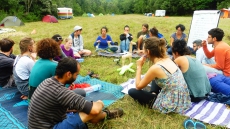 Naturally, the participants will consider their own needs first when making a decision. Your role as facilitators will be to help them adopt a point of view that goes “a little bit beyond” their own. What would be the consequences if their personal preference was applied to the group? Would it be the best solution for most of the group? Does it match with the partners' needs? Does it put anybody in danger or at unease? If it does, can the plan be changed a bit so it doesn't? Is the proposition manageable within the range of possible things (taking into account logistics, time, external constraints)?
Naturally, the participants will consider their own needs first when making a decision. Your role as facilitators will be to help them adopt a point of view that goes “a little bit beyond” their own. What would be the consequences if their personal preference was applied to the group? Would it be the best solution for most of the group? Does it match with the partners' needs? Does it put anybody in danger or at unease? If it does, can the plan be changed a bit so it doesn't? Is the proposition manageable within the range of possible things (taking into account logistics, time, external constraints)?
Taking a step back from one's own perspective is neither easy nor natural. You might explain the issues at stake to the participants and introduce them to concepts and approaches that might help them to better understand what it means in practical terms. What is an objection? Why distinguished it from a personal preference? What is Artful participation? How to give shape to the main principles it relies on?
Allow the participants to try, test, experiment the making-decision together on simple things at the beginning of the Tour, so that they can learn by doing and build on their own experience (including failures and success, mistakes, misunderstandings).
Provide good conditions for a decision to be made
Given the complexicity of making decisions on the account of a whole group (it IS a job after all!), any decision making process will require from you care, time and method.
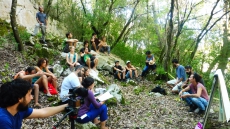 First, choose a relevant moment in the schedule and a relevant venue for the meeting to take place (where the group can stay focused, without external interruptions) and gather all the participants. Make sure everybody knows a meeting is happening and who want to be part of it can attend it;
First, choose a relevant moment in the schedule and a relevant venue for the meeting to take place (where the group can stay focused, without external interruptions) and gather all the participants. Make sure everybody knows a meeting is happening and who want to be part of it can attend it;
Second, provide clear information : what is the decision about, what are the different options the group has, what implies each of them;
Third set a time for the decision to be made, explain the method you will use, announce what will happen in case the group doesn't manage to reach an agreement in due-time and distribute roles in accordance with the decision making method you have chosen: who will be the “facilitator”, the “ time-keeper”, the “decision pusher”, etc. In case you want to use signs, remember all of them to the participant.
Only then can you start a decision making process with the method of your choice.
Choose the right method
Last but not least, think carefully which will be the best decision-making method for the specific issue you want to deal with. For example don't apply sociocraty or Consensum on an issue that doesn't really matter. It is a long process and people will get bored if nothing important is at stake.
Keep in mind there is no perfect method: each issue will call a different one. For this purpose, we recommend you to prepare in advance a set of methods and tools for decision making. It will allow you to deal peacefully with unexpected situations during the Tour while providing to the participants a meaningful knowledge.
Help people speak their voice during evaluation moments
Evaluations require to set up a profound communication in between the group. At the first stages of the Tour, maybe some members will not be comfortable enough to express in such a personal way (especially in English!) in front of others.
Therefore, we suggest you to:
- support the participants who encounter difficulties to express themselves in English.
Take a seat next to them in the circle to be able to translate what they say and what the others are saying. That way they will have the opportunity to express themselves with precision, especially on emotional topics where speaking proper English will not be their priorité. By giving them access to translation, you will allow them to focus on their feeling and on what they would like to say.
- vary the methods and tools. Select some use some that ease personal expression and especially the expression of feelings, such as the 2 following:
Photo-language with DIXIT Cards
Adopt rules and tools which help to distribute the speech, prevent the more talkative to take adavantage over others and boost the shyest or the more introvert.

